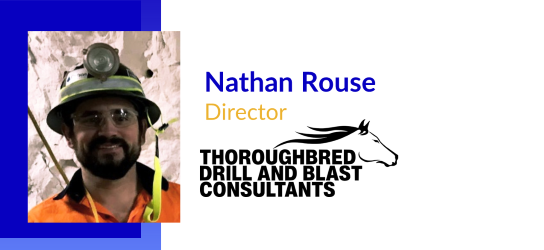Webinar Summary: Guidelines for Perimeter Control and Pre-Split Design
Webinar Summary: Guidelines for Perimeter Control and Pre-Split Design
Webinar Replay
Watch the On Demand Replay
Summary
Good pre-splitting and perimeter control in blasting is necessary both for bench maintenance and the safety and productivity of future shots. Good pre-splits and perimeter control, whether in quarries, open pit mining, or underground mining takes into account several factors including structural geology, stemming, and drilling accuracy.
Nathan Rouse, Director of Thoroughbred Drill & Blast Consultants discusses why blasters and operations should invest in pre-splitting and what they need to know to pull it off correctly.
Learn techniques to design perimeter control blasts for quarries, above ground metal mines, and underground tunnels, including:
* Pre-split blasting
* Trim blasting
* Other perimeter control blasting
And the factors that can affect its performance
* Jointing
* Stemming v. no stemming
* Drilling accuracy impact
Polls
With over 400 regitrants we had excellent audience participation. Here are the poll questions asked and their responses:

Q & A
1. Nathan do you use techniques post-blast, to verify the level of success or effectiveness of the wall control blast (e.g. Pre-split)
The easiest method that is quantitative to measure presplit success is to count the percentage of half barrels remaining after the blast. Half barrels don’t necessarily mean the blast was perfect, but they give a good indicator.
I’ve thought of coring into the wall and testing the rock (strength testing or other method) to see where the rock begins to exhibit more in-situ and non blasted behavior. This would help identify how far fractures extended into the rock. However, I haven’t had the opportunity to complete this testing or know how adequate it would be.
Another method is seismic refraction tomography. This method may not be practical for an operation to use frequently and would likely be used more academically. However, it is an option.
2. How does perimeter control technique reduce Hauling costs? I guess pre-split in underground development would be easier with electronic initiation?
Perimeter control reduces overbreak. Overbreak is a source of additional rock that needs to be mucked and hauled when it should have been left behind. Additionally, overbreak can produce oversize, which also increases the handling time (and therefore, expense) of loading and hauling and secondary breakage.
3. Is there a difference between trim and buffer blasting? Or it's just the term used?
I used trim blasting as a surface mining term. Where you have a smaller, narrow blast (possibly with smaller diameter holes) along the final wall to protect the wall.
Smoothwall blasting is a term I used for underground (or surface) where the perimeter row of holes is shot with the main production blast. The perimeter row is loaded with decoupled charges and fired after the production holes.
Buffer blasting is a term I used for a similar scenario as Smoothwalling except an additional buffer row is added between the production blast and the perimeter holes. The buffer row is lightly loaded (lower density explosive or slightly decoupled charges) compared to the production holes. But the buffer row will likely have a higher load than the perimeter holes.
4. For the poll 3, as a suggestion include as an option "improving ventilation". It is one of the reason that we use perimeter blasting on tunneling projects.
It’s quite possible. A smoother wall means that the air will have less resistance as it moves through the tunnels. Less resistance equates to reduced ventilation costs.
5. What about cushion holes between production holes and perimeter holes?
See Question 3, Paragraph 3
6. Smooth wall blasting - I thought we were trying to get away from powder factors?
I think some people have pushed to go away from powder factors and go towards an energy basis. In my experience, a lot of this is driven by explosives manufacturers trying to sell powder. Obviously, geology needs taken into account and so does the burden to bench height ratio. A 1 lb/cy powder factor on a 40 ft bench with a small diameter blasthole is not nearly the same as a 1 lb/cy powder factor on a 10 ft bench with a large diameter blasthole. However, for the purposes of the comparisons I was making in my presentation, powder factor is a useful metric to use. For example, with heading rounds, you typically use the same drillhole diameter and drillhole depth in similar geology, so comparing powder factors in this case is useful.
7.What is the main factor when choosing between pre-splitting and "post-splitting" techniques?
This really depends on the operation. Ultimately, it’s cost versus benefit. Presplitting is typically more costly, so an operation will want to make sure they get the benefit out of the increased cost. Geology, tunnel usage requirements (main haulage versus temporary access), Geotech, and other factors can also be the main factor.
8. What should be the depth of the pre split holes?
The height of the bench that is presplit. An operation may subdrill a presplit pattern to make sure the presplit pattern breaks to grade.
9. Is it advisable to charge line drilling holes in this sense, charge one hole and leave the other?
True line drilling holes would not be charged. They can be charged, but that would likely make the pattern a smoothwall pattern instead of a line drilling pattern.
In regards to the timing would you blast the burn first then the pre split followed by the rest of the holes?Presplit can be on the “zero” delay or 0 ms before the burn. Or it can be fired after the burn. The presplit just needs to be fired before the fracturing from any previously-fired holes intersect the final perimeter.
10. How is the direction of the water jet controlled?
The waterjet will have a nozzle that forms the waterjet. This nozzle will control the direction.
11. Are there rules of thumb for Pre-Splitting in non-competent rock geology?
Non-competent can be many things. In order to keep this response broad, I’ll just say that the more a geologic unit is non-competent, the smaller scale you may want the design. For a good presplit to be successful, you might need to reduce the hole diameter charge diameter, hole spacing, and hole length. Also the production holes may need to be reduced in diameter and charge weight to prevent fracturing from extending beyond the presplit.
12. Is there any impact of PPV in controlling damage to rock?
Damage from rock is due to permanent displacement beyond the yield strength of the rock. Displacement is a function of particle velocity and frequency. For those of you who took Calculus, the integral of particle velocity with respect to frequency is displacement.
So yes, peak particle velocity (PPV) can have an impact.
But typically when PPV is discussed, it is measured by a seismograph or accelerometer where the vibration is elastic (meaning the rock isn’t breaking). There are some equations that relate PPV to fracture distance. These equations may provide a reasonable estimate; however, keep in mind that the PPV you’re measuring is from elastic vibrations rather than where the rocks are breaking under a shocked load.
13. How would you measure the success of final wall blasting / perimeter control?
See Question 1
14. With regard to the perimeter control blasting seminar tomorrow, one of the determinants is the presence of water. Water can help the formation of a presplit but can adversely affect wall stability by inducing high hydraulic pressures from production blasting. Dewatering may be difficult or ineffective, so in cases where the ground remains saturated, please discuss the impact of high hydraulic pressures from the production blasting and what can be done to assure that those pressures do not pre-dilate the final wall when trim blasting or dilate the final wall past the presplit when presplit blasting.
For the best results, it is preferably to ensure the charges are decoupled from the rock with air, meaning dewatering is best. If presplit or other perimeter control holes cannot be dewatered, the water will reduce the impact of the decoupling. So water will allow more energy from decoupled charges to impact the surrounding rock. You may benefit from being able to place holes further apart, but you will also have more radial damage around the hole.
You might be able to counteract the impact of water coupling by using smaller diameter charges in the holes.
Speaker

Nathan Rouse has a BS, MS, and PhD from the University of Missouri - Rolla/Missouri S&T. He has over 13 years of experience in surface and underground mining globally with some of the largest companies in the industry. He is currently Director of Thoroughbred Drill and Blast Consultants.

New technologies are rapidly changing the drilling, blasting, mining, and aggregates industries, empowering them in ways never before possible. Make sure you are taking advantage of the best tools available.
Check out our 2 Free E-books on AI applications for the drilling, blasting, and mining industries to see all the amazing advances that are available.
AI Guide for Drilling and Blasting
AI Guide for Mining
Watch our videos:
YouTube
